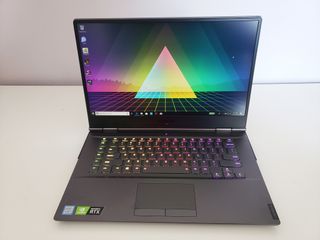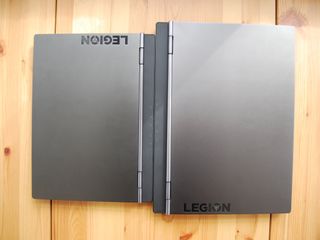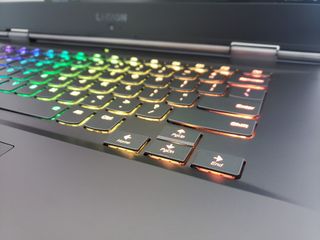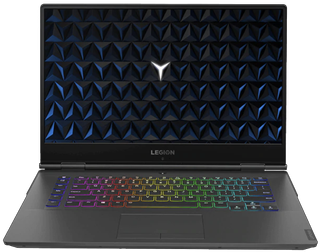
Which GPU should you choose in Lenovo's Legion Y740?
What is the price difference between GPUs?

Before getting into any sort of close look at benchmarks and performance, it's worthwhile to note the price difference between GPUs. In both the 15- and 17-inch versions of the Legion Y740, the NVIDIA RTX 2070 Max-Q (with 8GB of GDDR6 VRAM) costs $200 more than the baseline RTX 2060 (with 6GB of GDDR6 VRAM) when customizing your own model, with some pre-builts offering slight discounts.
The cheapest 15-inch Y740 you can buy costs about $1,580, which includes alongside the RTX 2060 an 8th Gen Intel Core i7-8750H — the same processor (CPU) found in all Y740 models — 16 GB of DDR4 RAM, and a 256GB PCIe solid-state drive (SSD). Upgrading to the RTX 2070 Max-Q brings the price up to about $1,820 (slightly more than $200) due to mandatory storage upgrades that come along with it.

The 15-inch Legion Y740 tops out at an RTX 2070, but the 17-inch Y740 can be had with up to a NVIDIA RTX 2080 Max-Q with 8GB of GDDR6 VRAM. On top of the price difference already in place for the larger chassis and display, you'll pay about $400 more for the RTX 2080 than for the RTX 2070, and about $600 more than the RTX 2060 when customizing your own model, again with some pre-builts offering discounts.
The cheapest 17-inch Y740 you can buy costs about $1,740 and comes with an RTX 2060, 16GB of DDR4 RAM, Core i7-8750H CPU, and a 1TB hard-disk drive (HDD). Adding an RTX 2080 and a mandatory 256 GB PCIe SSD brings the price up to about $2,220.
If you're looking to spend about $1,500 on one of these Legion gaming laptops, you really only have one option in the Y740 15 with RTX 2060 GPU. It's still going to bring the benefit of ray tracing and DLSS — two of the main selling points of the new RTX cards — and it will almost keep up with the RTX 2070 Max-Q. It really is a beast of a card, and it can also be had in the 17-inch Legion Y740 if you prefer a larger screen and don't mind paying the extra money for the bigger chassis.
If you have between $1,800 and $1,900 to spend, you can grab either the 15- or 17-inch Y740 with an RTX 2070 Max-Q GPU, which has the same 8GB of GDDR6 VRAM as the RTX 2080 Max-Q. There are, however, more performance differences you should know about before making a final decision.
How does the performance of these GPUs compare?

Though the RTX 2070 Max-Q's specs closely resemble those of the RTX 2080 Max-Q, the latter card is going to deliver better performance at a higher cost. This is seen in 3DMark Time Spy and Fire Strike benchmark tests.
Get the Windows Central Newsletter
All the latest news, reviews, and guides for Windows and Xbox diehards.
3DMark Time Spy
| GPU | Score range |
|---|---|
| RTX 2060 | 6,100 - 6,400 |
| RTX 2070 Max-Q | 6,200 - 6,500 |
| RTX 2080 Max-Q | 7,100 - 7,600 |
3DMark Fire Strike
| GPU | Score range |
|---|---|
| RTX 2060 | 14,300 - 14,900 |
| RTX 2070 Max-Q | 14,600 - 15,000 |
| RTX 2080 Max-Q | 16,300 - 16,700 |
Synthetic benchmarks are one thing, but how does the RTX 2070 Max-Q compare to the RTX 2080 Max-Q in actual games? We tested Metro Exodus — which supports ray tracing and DLSS — and Tom Clancy's The Division 2, one of the most detailed games on the market, to check framerates at 1440p.
With the RTX 2070 Max-Q, Metro Exodus averaged 105.6 FPS (60 minimum and 170 maximum) on High settings without ray tracing or DLSS enabled. The RTX 2080 Max-Q GPU averaged 125.6 FPS. With ray tracing and DLSS enabled, the RTX 2070 averaged 66.4 FPS (55 minimum and 85 maximum) and the RTX 2080 averaged 63.2 FPS.
In Tom Clancy's The Division 2, the RTX 2070 Max-Q averaged 73.4 FPS (34 minimum and 84 maximum) on High settings. The RTX 2080 Max-Q averaged 89.4 FPS. We didn't have a Legion Y740 with RTX 2060 in-house to test exact numbers, but framerates would be close when compared to the RTX 2070 Max-Q. In any case, it's clear that the RTX 2080 is going to bring higher framerates, but whether or not the performance is worth the extra money is really up to you.

One final thing to keep in mind is VRAM. While the RTX 2060 brings similar (though lesser) performance to the RTX 2070, it has 6GB of VRAM compared to 8GB of VRAM in the two beefier GPUs. VRAM handles stuff like frame buffers, textures, lighting, and shadows, so having more VRAM means you're going to have a better gaming experience at higher resolutions. While the RTX 2060 can handle 1080p and even 1440p without much issue, you want at least 8GB of VRAM when stepping up to anything higher.
There's also the longevity factor. As games become more detailed they use more VRAM, so if you plan on buying this laptop and using it for years to come — especially since you can upgrade RAM, HDD, and SSD in these models — that extra 2GB of VRAM will make a difference.
Be sure to have a look at our picks for best graphics card options for an idea of how these GPUs rank.
Which GPU should you choose?

Based on performance, price, and longevity factor, the NVIDIA RTX 2070 Max-Q makes the most sense for most people when choosing a GPU for the Legion Y740. It will remain relevant further into the future than the RTX 2060, it costs considerably less than the RTX 2080 Max-Q, and it will deliver a stellar gaming experience on the built-in display's 1,920 x 1,080 resolution or an external display at a higher resolution.
If you're on a tight budget, the RTX 2060 will definitely still bring awesome performance, and if you have the money to burn and just want the best hardware possible, you've probably already made up your mind on the RTX 2080.

Portable gaming
The Legion Y740 15 has a smaller display and RGB keyboard with extra macro keys, and it can be had with either an NVIDIA RTX 2060 or RTX 2070 Max-Q GPU.

Full range of GPUs available
The Legion Y740 17 brings a larger display, full RGB keyboard with number pad, and the option to upgrade to the NVIDIA RTX 2080 Max-Q GPU if your budget allows.

Cale Hunt brings to Windows Central more than eight years of experience writing about laptops, PCs, accessories, games, and beyond. If it runs Windows or in some way complements the hardware, there’s a good chance he knows about it, has written about it, or is already busy testing it.
